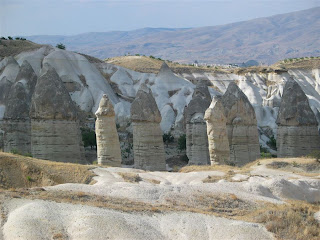Cappadocia was known as Hatti in the late Bronze Age, and was the homeland of the Hittite power centred at Hattusa. After the fall of the Hittite Empire, with the decline of the Syro-Cappadocians (Moschoi) after their defeat by Croesus in the 6th century, Cappadocia was left in the power of a sort of feudal aristocracy, dwelling in strong castles and keeping the peasants in a servile condition, which later made them apt for foreign slavery. It was included in the third Persian satrapy in the division established by Darius, but long continued to be governed by rulers of its own, none apparently supreme over the whole country and all more or less tributary to the Great King. Thoroughly subdued at last by the satrap Datames, Cappadocia recovered independence under a single ruler, Ariarathes (hence called Ariarathes I), who was a contemporary of Alexander the Great, and maintained himself on the throne of Cappadocia after the fall of the Persian monarchy.
The province was not visited by Alexander, who contented himself with the tributary acknowledgment of his sovereignty made by Ariarathes before the conqueror's departure from Asia Minor; and the continuity of the native dynasty was only interrupted for a short time after Alexander's death, when the kingdom fell, in the general partition of the empire, to Eumenes. His claims were made good in 322 BC by the regent Perdiccas, who crucified Ariarathes; but in the dissensions which brought to Eumenes's death, the son of Ariarathes recovered his inheritance and left it to a line of successors, who mostly bore the name of the founder of the dynasty.
Under Ariarathes IV Cappadocia came into relations with Rome, first as a foe espousing the cause of Antiochus the Great, then as an ally against Perseus of Macedon. The kings henceforward threw in their lot with the Republic as against the Seleucids, to whom they had been from time to time tributary. Ariarathes V marched with the Roman proconsul Publius Licinius Crassus Mucianus against Aristonicus, a claimant to the throne of Pergamon, and their forces were annihilated (130 BC). The imbroglio which followed his death ultimately led to interference by the rising power of Pontus and the intrigues and wars which ended in the failure of the dynasty.
The Cappadocians, supported by Rome against Mithradates, elected a native lord, Ariobarzanes, to succeed (93 BC); but it was not till Rome had disposed at once of the Pontic and Armenian kings that his rule was established (63 BC). In the civil wars Cappadocia was now for Pompey, now for Caesar, now for Antony, now against him. The Ariobarzanes dynasty came to an end and a certain Archelaus reigned in its stead, by favour first of Antony, then of Octavian, and maintained tributary independence till AD 17, when the emperor Tiberius, on Archelaus's death in disgrace, reduced Cappadocia at last to a province.
Cappadocia contains several underground cities (see Kaymaklı Underground City), largely used by early Christians as hiding places. The Cappadocian Fathers of the fourth century were integral to much of early Christian philosophy.
It later became a region of the Byzantine Empire, producing among other people a Patriarch of Constantinople, John of Cappadocia (held office 517–520). Many Cappadocians shifted to Turkish (written with the Greek alphabet, Karamanlidika) and where Greek was maintained (Sille, villages near Kayseri, Pharasa town and other nearby villages), it became heavily influenced by the surrounding Turkish. This dialect of Greek is known as Cappadocian Greek; following the 1923 population exchange that expelled Christians from the region, the language is now only spoken by a handful of the former population's descendants in modern Greece.
The Arab historian Abu Al Faraj, purports the following about the Armenian settlers in Sivas, during the 10th century: “Sivas, in Cappadocia, was dominated by the Armenians and their numbers became so many that they became vital members of the imperial armies. These Armenians were used as watch-posts in strong fortresses, taken from the Arabs. They distinguished themselves as experienced infantry soldiers in the imperial army and were constantly fighting with outstanding courage and success by the side of the Romans in other words Byzantine.
Reference:http://en.wikipedia.org/wiki/Cappadocia




















